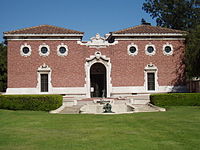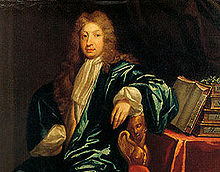- William Andrews Clark Memorial Library
-
William Andrews Clark Memorial Library 
Established 1924 Location Los Angeles, California Branches N/A Collection Size 110,000 (rare books); 22,000 (rare manuscripts) (2007) Access and use Circulation Library does not circulate Other information Budget US$30,000,000 (total endowment) Director Barbara Fuchs Staff 6 (FTE) Website Official website The William Andrews Clark Memorial Library (Clark Library), one of twelve official libraries at the University of California, Los Angeles, is one of the most comprehensive rare books and manuscripts libraries in the United States, with particular strengths in English literature and history (1641-1800), Oscar Wilde, and fine printing. It is located about thirteen miles from UCLA, in the West Adams District of Los Angeles north of the University of Southern California. It is administered by UCLA's Center for Seventeenth- and Eighteenth-Century Studies, which offers several prestigious fellowships for graduate and postdoctoral scholars to use the Library's collections.[1] However, any reader with a serious interest in the collection is welcome to study.
The heart of the Clark's academic activity is its core programs, a series of interdisciplinary events developed around a common theme. Core programs may range from three or four consecutive workshops to a series spanning a year or more, with a full complement of symposia, workshops, graduate seminars, and public lectures. The core programs are organized each year by the current Clark Professor or Professors, who are encouraged to design programs that will lead to publication in the Center/Clark series (published by the University of Toronto Press).[2]
Contents
History

The library and its collections were built by William Andrews Clark, Jr., in memoriam of his father, U.S. Senator William Andrews Clark, Sr. who amassed a mining fortune in Montana, Arizona, and Nevada. Clark Jr., a prominent collector and philanthropist, originally had a mansion at the corner of Adams Boulevard and Cimarron, but the structure was demolished.[3] The current library, designed by architect Robert D. Farquhar, was constructed from 1924 to 1926 on the same site. After its completion, Clark Jr. announced his intent to donate the collection, the buildings, and the square-block property to the University. The deed was transferred upon his death in 1934. It was UCLA's first major bequest, and still one of the most generous in the university's history.[4]
Collections
The early twentieth century ushered in a heyday of American book collecting.[citation needed] William Andrews Clark, Jr., along with other moneyed bibliophiles such as J. Paul Getty, Henry E. Huntington and Henry Clay Folger, first began forming his library during this period.
Initially, Clark collected a broad array of English imprints. His library included the four Shakespeare folios; important editions of Chaucer, Ben Jonson, Byron, Dickens, and Robert Louis Stevenson; works illustrated by George Cruikshank and William Blake; French literature from Pierre de Ronsard to Émile Zola; autograph letters and manuscripts by authors, statesmen, and musicians; and materials relating to the exploration of the American West. In time, Clark began to concentrate his collecting on English literature of the seventeenth and eighteenth centuries, particularly in the Restoration, which defines the strengths of the Clark Library today. Eventually, Clark also developed a large collection of Oscar Wilde books and manuscripts.
Clark also took an interest in fine printing, which is represented by complete runs of the books printed by the Kelmscott Press and Doves Press, the two greatest influences on the revival of printing in England at the turn of the century.[5] The library also has a substantial collection of American fine presses in the Arts and Crafts Movement, particularly Californian printers, as well as the library and papers of printer and sculptor Eric Gill and Los Angeles artist Paul Landacre. The library continues to collect in this field.
As of 2006, the collection contains over 110,000 rare books and 22,000 manuscripts, in addition to an extensive reference collection of modern books, periodicals and microfilm.[6]
17th and 18th centuries
The Clark Library is one of the most extensive for British literature and history from the English Civil War through the reign of George II (1641-1761).[7] Many of its collections are only rivaled by the British Library, especially its literary collections, which include literary giants John Dryden, John Milton, Daniel Defoe, Jonathan Swift, Alexander Pope, Henry Fielding, and Aphra Behn. The Clark Library also has substantial collections of music books and songs, scores, and musicology printed before 1750; ballad and comic operas; the edited works of Purcell, Handel, and their contemporaries in England; and a choice collection of manuscript anthems, hymns, and incidental music assembled by Theodore Finney.
Among its most valuable collections are the scientific works of Isaac Newton, Robert Boyle, Edmond Halley, John Evelyn, and Digby. The Library also holds theological and philosophical collections of Thomas Cartwright, Protestant theology, Thomas Hobbes, John Locke, and David Hume.
Oscar Wilde Collection
Perhaps the Library's most valuable and extensive collection is the work by and relating to Oscar Wilde. It is considered the most comprehensive collection of its kind in the world.[8] Clark originally purchased Wilde manuscripts from Wilde's son, Vyvyan Holland, among others. Today, the collection includes photographs, original portraits, caricatures, playbills, and news cuttings. Most of the important Wilde studies in recent years have drawn heavily upon the Clark's resources. The Clark has also taken to collecting books and manuscripts of Wilde's literary circle and the decadent and modernist movements of the 1890s, including the most important editions of William Butler Yeats and many others.
Fellowships
 Clark Library logo
Clark Library logo
Several types of fellowships are offered for graduate and postdoctoral scholars to study at the Clark Library. Among the most prestigious are the Ahmanson-Getty Fellowship, Andrew W. Mellon Fellowship, Clark Dissertation Fellowship, Predoctoral Fellowship, American Society for Eighteenth-Century Studies /Clark Fellowship, Kanner Fellowship in British Studies, Clark Short-Term Fellowship, and Clark-Huntington Bibliographical Fellowship.
All fellowships are administered by UCLA's Center for Seventeenth- and Eighteenth-Century Studies. Each fellowship varies in stipend, duration, and qualification. All of the fellowships, however, require that the recipient make use of the Clark Library's collections.[9]
Images of Clark Library
See also
- List of Los Angeles Historic-Cultural Monuments in South Los Angeles
- Mary Andrews Clark Memorial Home
- Huntington Library
- UCLA Library
References
- ^ "Center for Seventeenth- and Eighteenth-Century Studies William Andrews Clark Memorial Library". UCLA Center for Seventeenth- and Eighteenth-Century Studies. http://www.humnet.ucla.edu/humnet/c1718cs/Postd.htm. Retrieved 2007-04-28.
- ^ "Center for Seventeenth- and Eighteenth-Century Studies William Andrews Clark Memorial Library". William Andrews Clark Memorial Library. http://www.humnet.ucla.edu/humnet/c1718cs/pubs.htm. Retrieved 2007-04-12.
- ^ "About the Clark Library". William Andrews Clark Memorial Library. http://www.humnet.ucla.edu/humnet/clarklib/Clark%20Pages/About.htm. Retrieved 2007-04-28.
- ^ "TOP 10 GIFTS". UCLA Today. http://www.today.ucla.edu/2000/000111gifts.html. Retrieved 2007-04-28.
- ^ "Fine Printing and Graphic Arts". William Andrews Clark Memorial Library. http://www.humnet.ucla.edu/humnet/clarklib/Clark%20Pages/Collection%20Links/Fine%20Printing%20and%20Graphic%20Arts.htm. Retrieved 2007-04-28.
- ^ "Professional Position Posting". lisjobs.com. http://www.lisjobs.com/jobs/details.asp?ID=34078. Retrieved 2007-04-28.
- ^ "The Seventeenth and Eighteenth Centuries". William Andrews Clark Memorial Library. http://www.humnet.ucla.edu/humnet/clarklib/Clark%20Pages/Collection%20Links/The%20Seventeenth%20and%20Eighteenth%20Centuries.htm. Retrieved 2007-04-28.
- ^ "Oscar Wilde and the 1890s". William Andrews Clark Memorial Library. http://www.humnet.ucla.edu/humnet/clarklib/Clark%20Pages/Collection%20Links/Oscar%20Wilde%20and%20the%201890s.htm. Retrieved 2007-04-12.
- ^ "Fellowships and Other Support Programs". UCLA Center for Seventeenth- and Eighteenth-Century Studies. http://www.humnet.ucla.edu/humnet/c1718cs/Postd.htm. Retrieved 2007-04-12.
- University of California (1946). William Andrews Clark Memorial Library: Report of the First Decade, 1934-1944. Berkeley; Los Angeles: University of California Press. OCLC 768715.
External links
- Official website
- The Clog: the Blog of the William Andrews Clark Memorial Library, maintained by the Clark staff
Los Angeles Historic-Cultural Monument Lists Downtown Los Angeles • East and Northeast Sides • Harbor Area • Hollywood • San Fernando Valley •
Silver Lake, Angelino Heights and Echo Park • South Los Angeles • Westside • Wilshire and Westlake AreasCategories:- University and college academic libraries in the United States
- University of California, Los Angeles buildings and structures
- University of California, Los Angeles
- Libraries in Los Angeles, California
- Educational institutions established in 1924
- Beaux-Arts architecture in California
- Palladian Revival architecture in California
- Mediterranean Revival architecture in California
Wikimedia Foundation. 2010.














